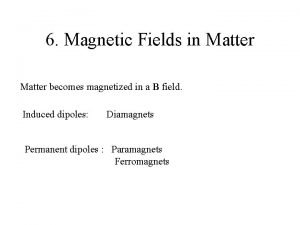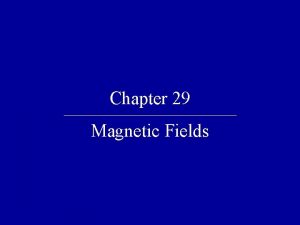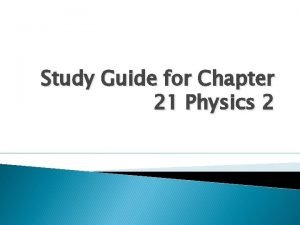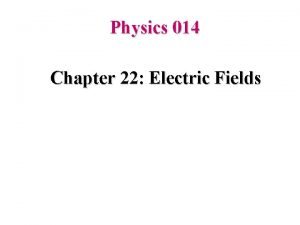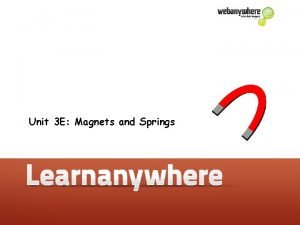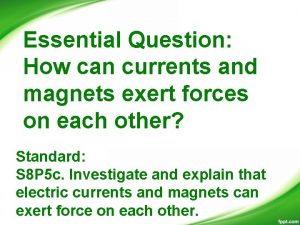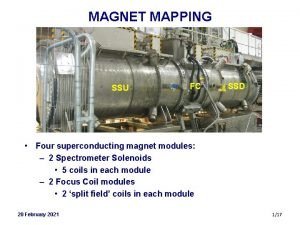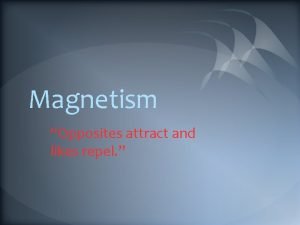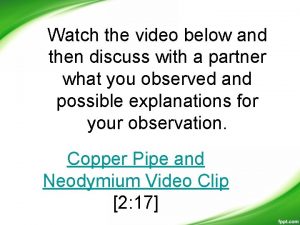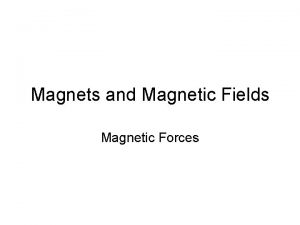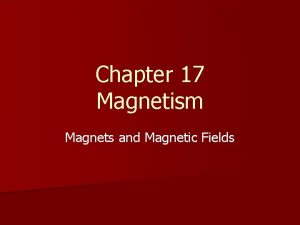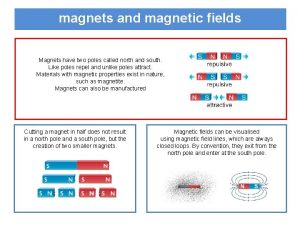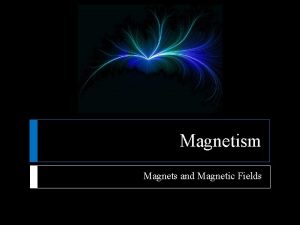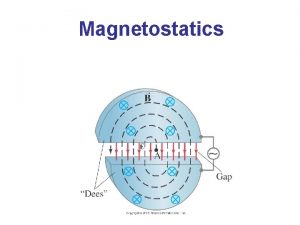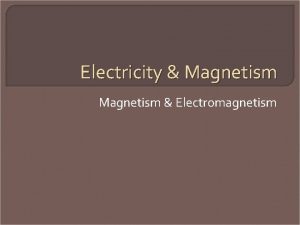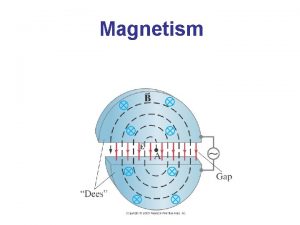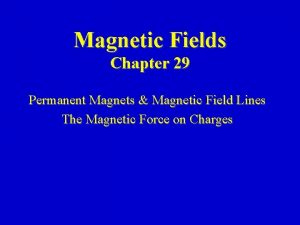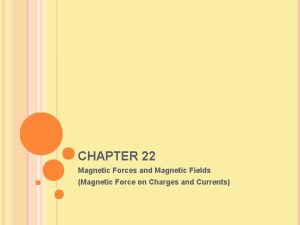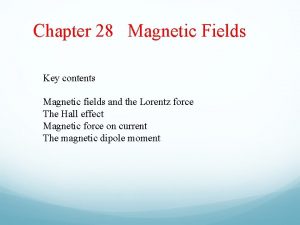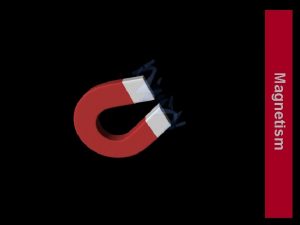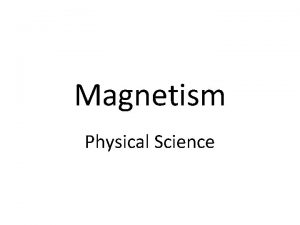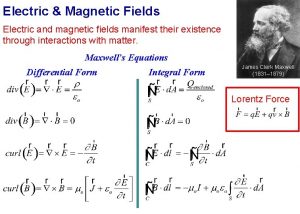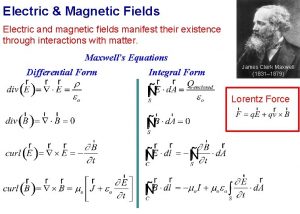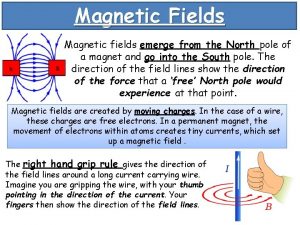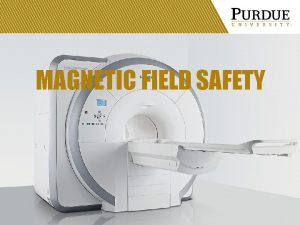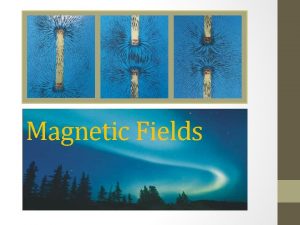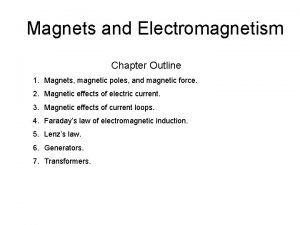MAGNETS AND MAGNETIC FIELDS Chapter 14 1 MAGNETS





















- Slides: 21

MAGNETS AND MAGNETIC FIELDS Chapter 14. 1

MAGNETS AND MAGNETIC FIELDS • Magnets got their name from the region of Magnesia, which is now part of modern-day Greece. • The first naturally occurring magnetic rock, called lodestones, were found in this region. • A lodestone is composed of an iron-based material called magnetite.

MAGNETS AND MAGNETIC FIELDS • Some substances, such as lodestones, are magnetic all the time. These types of magnets are called permanent magnets. • Other substances can be converted into permanent magnets. • For example, a piece of iron. • By striking it several times with a permanent magnet, it can become permanently magnetic. • Another method is by placing the iron near a strong magnet and eventually, the iron will become magnetic and remain that way even when the magnet is removed.

MAGNETS AND MAGNETIC FIELDS • So, we can take an nonmagnetic material and make it magnetic, but can we take the magnetism away? • Yes: we can either weaken the force or completely remove it. • Possible ways to do this include heat, or hammering the piece of iron. • https: //www. youtube. com/watch? v=Lj 6 c 5 ebi 0 a 4

MAGNETS AND MAGNETIC FIELDS • Scientists classify materials as either magnetically hard of magnetically soft. • Iron is a soft magnetic material. • Although iron is easily magnetized, it also tends to lose its magnetic properties easily. • Cobalt and Nickel are hard magnets • These materials are more difficult to magnetize. Once magnetized, they don’t lost their magnetism easily.

MAGNETS AND MAGNETIC FIELDS • Magnets exert magnetic forces on each other. • Figure 14 -3 • A magnet is lowered into a bucket of nails. As soon as a nail touches the magnet, the nail then acts as a magnet and attracts other nails. • The magnetic force involved is limited, however. • It is dependent upon the strength of the magnet as well as the distance from magnet to nail.

MAGNETS AND MAGNETIC FIELDS • Like poles repel, and opposite poles attract. • Magnetic pole – an area of a magnet where the magnetic force appears to be the strongest. • Magnets have a pair of poles, a north pole and south pole. • You cannot isolate a south magnetic pole from a north. If a magnet is cut, it will always have two different poles. • Two like poles, such as two south poles, repel each other. • Two unlike poles, such as a north and a south, attract one another

MAGNETS AND MAGNETIC FIELDS • Magnetic field – a region where a magnetic force can be detected. • When magnets repel or attract, it is due to the interaction of their magnetic fields.

MAGNETISM FROM ELECTRIC CURRENTS Chapter 14. 2

MAGNETISM FROM ELECTRIC CURRENTS • The magnetic field of a coil of wire resembles that of a bar magnet. • Solenoid – a long, wound coil of insulated wire. • The strength of a solenoid depends on the number of loops of wire and the amount of current in the wire.

MAGNETISM FROM ELECTRIC CURRENTS • The strength of a solenoid’s magnetic field can be increased by inserting a rod made of iron (or some other potentially magnetic metal) through the center of the coils. • The resulting device is called an electromagnet.

MAGNETISM FROM ELECTRIC CURRENTS • Domain – a microscopic magnetic region composed of a group of atos whose magnetic ields are aligned in a common direction.

MAGNETISM FROM ELECTRIC CURRENTS • Galvanometers are instruments that measure the amount of current in a circuit. • Electric motor – a device that converts electrical energy to mechanical energy.

CLASSWORK • Pg. 467, #1, 2 • Pg. 473, #3

ELECTRIC CURRENTS FROM MAGNETISM Chapter 14. 3

ELECTRIC CURRENTS FROM MAGNETISM • Electromagnetic induction – the production of a current in a conducting circuit by a change in the strength, position, or orientation of an external magnetic field. • In 1831, Michael Faraday discovered that a current can be produced by pushing a magnet through a coil of wire. • Faraday’s Law • An electric current can be produced in a circuit by a changing magnetic field.

ELECTRIC CURRENTS FROM MAGNETISM • Generators convert mechanical energy to electrical energy. • Generator – a device that uses electromagnetic induction to convert mechanical energy to electrical energy. • Alternating current – an electric current that changes direction at regular intervals; also called AC • The generators that produce the electrical energy that you use at home are alternating current generators.

ELECTRIC CURRENTS FROM MAGNETISM • One of the most common sources of mechanical energy is running water. • Dams harness the kinetic energy of water. As the water falls from small channels at the top of the dam to the base, it turns the blades of a turbine • The end result of this process is electrical energy. • Another example is burning coals. • This produces steam that eventually turns the blades of the turbines

ELECTRIC CURRENTS FROM MAGNETISM • Transformers – devices that can change one alternating-current voltage to a different alternating-current voltage. • Ex. Cylinders on power lines • Transformers have two circuits; primary and secondary. • These two circuits (wires) are coiled around opposite sides of a iron loop. • One wire is attached to a source of alternating current, such as a power outlet. The other wire is attached to an appliance, such as a lamp.

ELECTRIC CURRENTS FROM MAGNETISM • Step-up transformer – voltage across the secondary coil is greater than the voltage across the primary coil. • Step-down transformer – voltage across secondary coil is lower than the voltage across the primary coil

CLASSWORK • Pg. 480, #1, 2, 3 • Pg. 481, #1, 2, 3, 4, 7, 8, 9, 12, 15
 Magnets and magnetic fields lesson 1 answer key
Magnets and magnetic fields lesson 1 answer key Red fields to green fields
Red fields to green fields Learning: module 26: magnetic forces and fields
Learning: module 26: magnetic forces and fields Electric currents and magnetic fields
Electric currents and magnetic fields Electric currents and magnetic fields
Electric currents and magnetic fields Scrap yard magnet how it works
Scrap yard magnet how it works Magnetic field in matter
Magnetic field in matter Lesson quiz 29-1
Lesson quiz 29-1 Hysteresis loop magnetism
Hysteresis loop magnetism Weber magnetism
Weber magnetism Magnetic moment and magnetic field relation
Magnetic moment and magnetic field relation F=i(lxb)
F=i(lxb) Chapter 16: electric forces and fields answers
Chapter 16: electric forces and fields answers Chapter 33 conceptual physics
Chapter 33 conceptual physics Chapter 21 study guide electric fields answers
Chapter 21 study guide electric fields answers Chapter 22 electric fields
Chapter 22 electric fields Magnets and springs
Magnets and springs The properties and interactions of magnets are called
The properties and interactions of magnets are called Explain how currents and magnets exert forces on each other
Explain how currents and magnets exert forces on each other Ssd and magnets
Ssd and magnets With magnets likes repel and opposites
With magnets likes repel and opposites Currents and magnets summarizer
Currents and magnets summarizer






